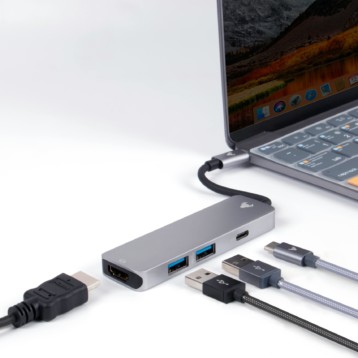
It’s no secret that living in today’s modern world means small businesses everywhere must take advantage of technology to have a competitive edge. The trouble is that many of those firms need to catch up with the latest tech innovations.
You’re likely reading this article today because you own or manage a small business and are still determining whether it’s making the best use of its tech resources or, indeed, if you even have the right tools for each job!
The following twenty ideas, concepts, and tips will help you ramp up your firm’s IT and use the best cutting-edge technology, resulting in a smoother, more streamlined, and more productive operation. Take a look:
1. Devise An IT Roadmap
Devising an IT roadmap for your firm makes perfect sense because it can help you plan and implement technology solutions that align with your business goals and sustain your growth. Your roadmap should include the following points:
- Business objectives;
- Assessment of existing IT infrastructure;
- Technology trend research;
- The IT solutions that are a priority for your small business;
- A timeline of how and when you will implement the solutions to meet your business objectives.
2. Embrace Cloud Computing
These days, more businesses like yours realize the potential that cloud computing has to offer.
From running complex mathematical tasks with computer power provided by an Internet server to cloud workspace solutions that don’t require expensive local hardware, there’s something for everyone in the cloud.
Why else should you embrace cloud computing? The biggest reason is the cost savings, and equally important is the ease of scalability.
3. Look To Automation For Help
More small businesses are depending on automation to scale up their IT processes. For example, using robotics to carry out repetitive work means that employees can utilize their skills in other areas or support different operational requirements.
Embracing automation in your organization is an excellent way to ramp up your IT because it offers numerous benefits, such as increased efficiency, better accuracy, and lower operational costs.
4. Expand Your Use Of Mobile Technology
It’s no secret that many employees always keep their mobile devices within eye contact. For example, a study by Udemy concluded that 87% of workers have their devices where they can see them. Surveys by other sources also report similar statistics.
Expanding your firm’s use of mobile technology will be beneficial in so many ways:
- Employees will find it easier to communicate with customers and each other;
- It’s cheaper for firms to use mobile devices than fixed landlines and other communication methods;
- Customers and employers can find it easier to track down field staff and get instant answers to their questions.
5. Create A Strong IT Cybersecurity Policy
According to Verizon’s data breach investigations report, 43% of cybercrime victims were small businesses. Moreover, cybercriminals typically target them because of inferior security measures.
That’s why it makes sense to have a firm IT cybersecurity policy in place as part of your efforts to ramp up your business’s IT. Having such a policy means your firm can better protect sensitive data and minimize the risk of financial losses.

6. Gain Insights In Your Business Data
Another way to ramp up your IT processes is by gaining insight into your business data.
Doing so will help you identify areas for improvement, such as upgrading systems and Internet connections if your outdated infrastructure is causing your business to operate inefficiently.
Business data insight can also help you identify trends and patterns, enabling you to make better financial and operational decisions.
7. Lease Your IT Equipment Instead Of Buying
It might not seem like it, but leasing your IT equipment instead of buying it makes perfect business sense and helps you ramp up your IT infrastructure in many ways.
A study by ELFA (Equipment Leasing and Finance Association) suggests that leasing helps businesses save 30% on IT equipment costs. There are also maintenance, support, and tax benefits compared to outright purchases.
8. Have An IT Equipment Upgrade Plan In Place
Whether you lease or buy your IT equipment, having an upgrade plan in place is a good idea. Doing so ensures that you keep productivity at high levels, bolster security, and decrease the risk of equipment breakdowns.
Also, it’s worth remembering that consumers are more likely to have confidence in small businesses that invest in modern and reliable IT equipment.
9. Formulate A Disaster Recovery Plan
Every business, regardless of size, should have a disaster recovery plan:
- Having such a plan means minimizing downtime from unexpected issues;
- You ensure that sensitive data like customer and financial information is kept safe;
- Business continuity is likely, as is reducing risk to operational processes;
- The law requires some businesses to follow regulatory compliance procedures by having a robust disaster recovery plan in place.
10. Sell Your Products & Services Online
If your small business’s IT operations are 20 years behind its competitors, one way to bring them into the 21st century is by selling your products and services online.
E-commerce offers many advantages to firms, such as increased reach, consumer convenience, lower costs, and a 24/7 storefront.
You will find that many e-commerce solutions can connect to internal IT systems for seamless order processing and credit control functions.

11. Get Your Staff To Use Collaboration Tools
Is your small business guilty of being inefficient? If so, one way to combat that problem is by having your teams use collaboration tools.
Such solutions ensure there is no risk of duplication, staff will make fewer mistakes, and they can work together on projects from different sites or locations. One example of a popular collaboration tool is Microsoft Teams.
12. Use Online Digital Marketing Solutions
Some small businesses waste time and money on offline marketing ideas and projects. A better use of those resources is with digital marketing, and plenty of IT solutions exist to help meet individual needs.
For instance, you could use tools like SEMRush to handle your online reach or an outsourced marketing agency to manage social media marketing and SEO (search engine optimization).
13. Use A CRM System
CRM is an acronym for Customer Relationship Management.
A CRM helps small businesses like yours manage their interactions with new and existing customers. It includes contact and lead management, data analytics, and forecasting tools, among other valuable features.
Using a CRM will help you ramp up your IT by streamlining how you deal with customers and make business decisions based on what they buy.
14. Ask Leaders To Use Project Management Tools
Your small business likely deals with projects for specific customers. IT can be very beneficial in helping with project management for several reasons:
- All project stakeholders can work towards clear goals;
- Risk management is easy to incorporate and execute;
- It’s easier for teams to work together and provide customers with better-than-expected results.
15. Ensure Your Staff Have The Right IT Training
Having the latest equipment at your premises is undoubtedly one way to ramp up your IT, but only if people fully understand how to operate them! That’s why you must have a clear and consistent training program for all employees.
Consider partnering with an external training provider to deliver the proper training to your staff.
16. Make Use Of Outsourced IT Providers
If organizing your firm’s IT infrastructure, support, and maintenance fills you with fear and dread, outsourcing those tasks to an external IT provider is a good idea.
Thankfully, you can leave your business’s IT needs in the capable hands of a professional that will save you time, money, and stress!
17. Encourage Virtual Meetings Via Tools Like Skype
There’s no denying that COVID-19 has changed how small businesses operate in today’s modern world. COVID-19 is still at the forefront of people’s minds, as is ensuring safe working practices.
One way to ease your team’s minds is by encouraging COVID-safe virtual meetings using online tools like Skype.
18. Invest In Sustainable Technology
Everyone wants to lead greener lifestyles and help the environment as much as possible, and businesses must be more eco-friendly these days. Did you know sustainable technology is an excellent way to achieve that goal?
For example, cloud computing reduces the need for in-house IT resources, and many data centers are carbon-neutral.
19. Regularly Audit Your IT Equipment
What IT equipment do you have? How old is each device? When were they last maintained? If you don’t know the answers to basic questions like those, you need to put in place a regular IT audit at your small business.
Doing so will significantly improve your firm’s IT operations and positively impact other areas, such as productivity, efficiency, and cost.
20. Encourage Staff To Use Their Own Devices
Consider implementing a BYOD (Bring Your Own Device) policy at your workplace. You could incentivize workers to use their mobile phones and laptops, such as offering extra paid holidays or other perks, while lowering your IT costs and maintenance requirements.










